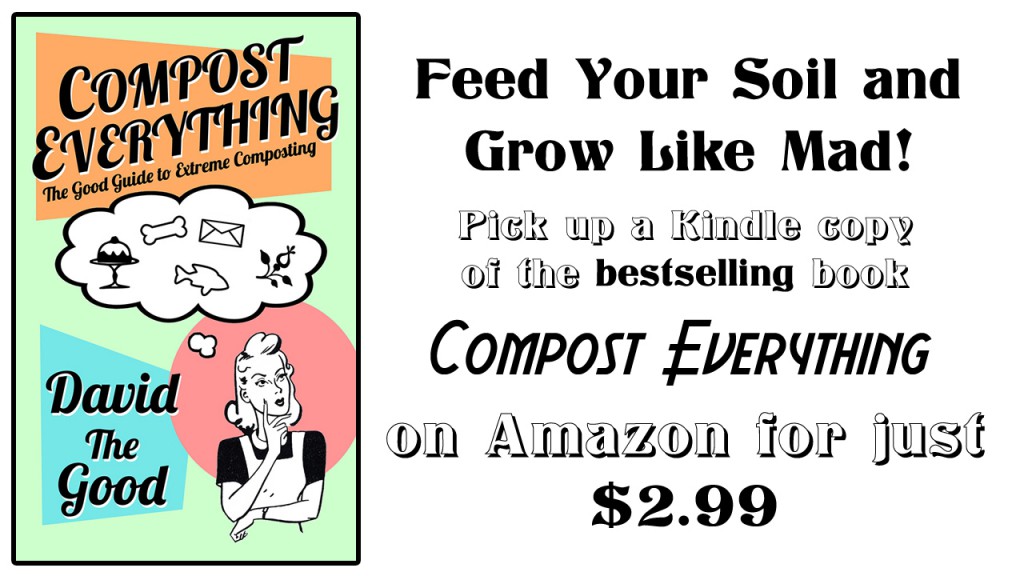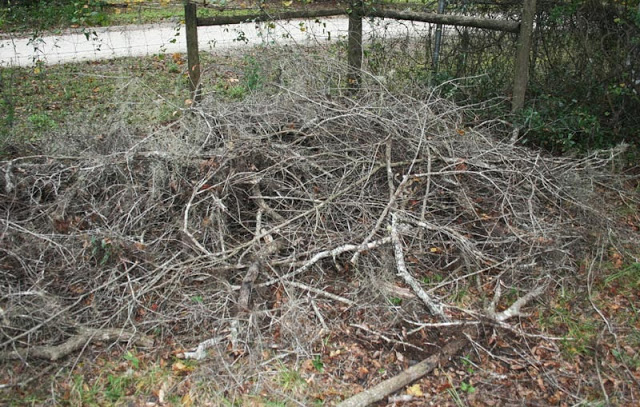Rather than worrying about barrels and flues and infrastructure, it’s time to start making easy biochar!
As I wrote Friday, I’m attempting to enrich a chunk of lousy dirt in the middle of my front yard. My food forest project is suffering in that area.
A not insignificant part of that attempt involves biochar. As regular readers know, I’m an obsessive and extreme composter.

Yes, I am an extreme composter. Get my book and you can be too.
I hate letting anything go to waste – so when I see neighbors cutting down trees or throwing out yard waste, I ask them to send it my way. Last year, two different families dumped piles of oak branches over my front fence for me.
They’ve sat there long enough that the lower layers have decomposed, enriching the ground beneath – but the top was perfect for burning:
So… burn I did. When I burned, I let the fire get down to good hot coals, then raked out the still uncharcoalified pieces of stick and log and made them a foundation of a new fire, then put out the remaining coals with the hose.
I got this:
In the end, that stick pile yielded a 1.5 trash can’s worth of biochar.
Biochar is a nutrient-holding amendment that should be perfect for Florida’s sandy soil. My next step is to mix this char into a drum of wet compost and let it soak in microbial life and nutrients. Then I’ll spread it around and mulch over it.
I’ve seen all kinds of more complicated ways to make this stuff. I prefer just building fires and putting them out. If I’m not making easy biochar, I won’t be making any! Besides, the last thing I need is another corner of the yard being consumed with a Char-O-Matic SuperDrum or something.
Are you using biochar in your garden? Any luck? Let me know!





7 comments
Hi David,
Open burning for char production should be a last resort, for remote locations and subsistence agriculture. The open burn should be a pyramid, top down burn to create pyrolysis conditions and needs to be managed closely for safety and efficient production. Much better to make a drum TLUD… I knocked 1 up with my brother in 1/2hr with scrap drums and an angle grinder.
Biochar production is much more efficient, less polluting and safe. And there are many other better ways to make biochar that don't require supervision… http://soilcarbon.org.nz/biochar-workshop/
Cheers, Trevor
Thanks for the link, Trevor. I'm not worried about pollution… nature makes a lot more smoke than I could ever manage. I consider my burning as rain-making.
A drum TLUD would be fun, though. That's something to chew on.
I haven't made a TLUD, but I do cover my biochar burns with dirt or wet leaves. You lose a lot of useful carbon into the atmosphere otherwise–especially if the dry wood is totally engulfed in flame. All that smoke and floating ash is charred wood that's not going into your garden. Plus, I believe the controlled burn to create charcoal rather than ash provides more structure for water retention and microbial yadda yadda YKWIM.
David,
I have made biochar that way. It's quick and easy when dealing with a lot of branches. I'm sure there are ways to make better biochar but the charcoal you're making is microporous and it will do the job.
Have you seen an increase in plant growth when you add biochar to the soil?
My intuitive sense is that biochar itself is neutral to the soil. Adding biochar alone won't help poor soil, but if you give it time to mix with some serious compost, it provides a good receptacle for soil nutrition and microbes.
So far in my experiments, my best results were with a mixture of charred and half-charred wood and lots (I mean LOTS) of wet leaves and pine needles mixed with dirt, left to sit and compost for a few months before using. I didn't seem to get a lot of benefit just from adding crushed charcoal alone to a patch of poor soil.
As I've explained to David before, the first time it happened was by accident, as I was trying to smother a huge fire I had created to reduce a pile of trees and brush. I had the hose going on the fire full-time and I used a tractor to keep pushing piles of wet leaves mixed with dirt on the fire. I was trying to kill it in time to get home for dinner. Turns out the wet pile contained a slow burn that smoked for days (I kept trying to put it out with the hose), leaving me with a pile of black stuff that looked suspiciously like soil. So I figured I would move some of it over to my utterly useless garden and mix it with a couple lame compost heaps I had started I ended up with six huge compost heaps that I later spread into raised beds. Next year my garden was not so useless…
Home Made, Low Tech, Clean Biochar;
Japanese Cone Kiln;
http://www.greenyourhead.com/2013/04/ez-biochar-the-japanese-cone-kiln.html
Moxham’s Ring Kiln;
http://biocharproject.org/charmasters-log/big-biochar-bash/
Can & Can Retort;
http://holon.se/folke/carbon/simplechar/simplechar.shtml
JRO; TLUD / Retort hybrid
http://www.youtube.com/watch?v=Kg95KYrH8PI
BioChar Producing BBQ Grill
http://www.chipenergy.com/
Comments are closed.